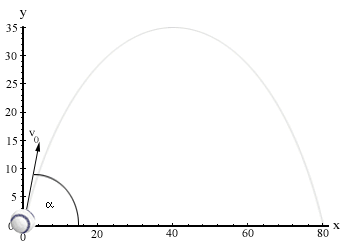
3. This problem examines the flight of a baseball. We will ignore the effects of air resistance and try to determine how far we can throw the ball. Assume that we can throw the ball with a velocity of v0 = 25 m/sec (approx. 56 mph). We want to determine how far can we throw the ball as we vary the angle a.
a. We want to follow the trajectory of the ball in its x and y coordinates, assuming the only force acting on the ball is gravity in the y-direction (which is -9.8 m/sec2). If the initial velocity is v0 with an angle of a to the ground, then the x-component of the velocity is v0cos(a) and the y-component is v0 sin(a). If v(t) and w(t) are the velocities in the x and y directions respectively, then Newton's Law of motion gives the following initial value problem describing the velocity of the ball:
w'(t) = -g = -9.8, w(0) = v0 sin(a).
Solve for the velocities in the x and y directions. Note that this is simply finding the anti-derivatives for the right hand side of each of the differential equations above.
b. By taking one more anti-derivative and using the initial positions x(0) = 0 and y(0) = 0, you can determine the positions x(t) and y(t) as functions of time. Write the solutions x(t) and y(t) as functions of t and a. Plot on a single graph the trajectories when a = p/10, p/5, 3p/10, and 2p/5. Find the maximum height for each of these trajectories. (Note that this occurs when w(t) = 0.)
c. Find when the ball hits the ground by solving y(t) = 0 for t, giving the value of t as a function of a. To find the maximum distance you substitute this value of t into the equation for x(t), then maximize x as a function of a. Give the angle for the path that maximizes the distance that the ball travels and determine this maximum distance. Plot the trajectory of the flight of the ball that travels the farthest and give its maximum height.
d. In this part of the problem we want to hit a specific target (say the cutoff man or woman). Find the angles (and there are two of them) that will cause the ball to hit the ground after traveling 50 meters. Also, determine how long the ball stays in the air for each of these flights. Graph both trajectories on a single graph, labeling the paths with their respective times of flight.
